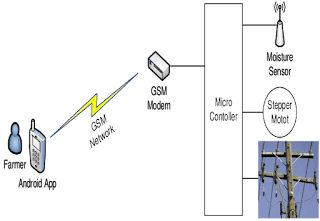Introduction
The continuous increasing demand of the food requires the rapid improvement in food production technology. In a country like India, where the economy is mainly based on agriculture and the climatic conditions are isotropic, still we are not able to make full use of agricultural resources. The main reason is the lack of rains & scarcity of land reservoir water. The continuous extraction of water from earth is reducing the water level due to which lot of land is coming slowly in the zones of un-irrigated land. Another very important reason of this is due to unplanned use of water due to which a significant amount of water goes waste. In the modern drip irrigation systems, the most significant advantage is that water is supplied near the root zone of the plants drip by drip due to which a large quantity of water is saved. At the present era, the farmers have been using irrigation technique in India through the manual control in which the farmers irrigate the land at the regular intervals.
This process sometimes consumes more water or sometimes the water reaches late due to which the crops get dried. Water deficiency can be detrimental to plants before visible wilting occurs. Slowed growth rate, lighter weight fruit follows slight water deficiency. This problem can be perfectly rectified if we use automatic micro-controller based drip irrigation system in which the irrigation will take place only when there will be intense requirement of water.
Irrigation system uses valves to turn irrigation ON and OFF. These valves may be easily automated by using controllers and solenoids. Automating farm or nursery irrigation allows farmers to apply the right amount of water at the right time, regardless of the availability of labor to turn valves on and off. In addition, farmers using automation equipment are able to reduce runoff from over watering saturated soils, avoid irrigating at the wrong time of day, which will improve crop performance by ensuring adequate water and nutrients when needed. Automatic Drip Irrigation is a valuable tool for accurate soil moisture control in highly specialized greenhouse vegetable production and it is a simple, precise method for irrigation. It also helps in time saving, removal of human error in adjusting available soil moisture levels and to maximize their net profits.
Type of Irrigation
- Ditch Irrigation
- Terraced Irrigation
- Drip Irrigation
- Sprinkler System
- Rotary Systems
Ditch Irrigation: Ditch Irrigation is one of the old methodology, where ditches are dug out and seedlings are planted in horizontally aligned pattern. Water is made to move to different canals via siphon tubes.
Terraced Irrigation: In this process the land is cut into multiple steps and supported by keeping walls while the plain areas are used for plantation and the idea is that the water runs down each step watering each column. This led steep land to be used for multiple crops. This is a very labour involvement method of irrigation.
Drip Irrigation: The most water effective method of irrigation is the drip irrigation method. In this method, water is dropped near the root level of a plant in a slow steady motion. The loss of water through evaporation and runoff can be decreased to a much high extent if the system is installed effectively.
Sprinkler System: This irrigation system is designed on overhead sprinklers fixed on permanent risers. The system is installed underground and the sprinklers level up when water pressure increases, which is a famous irrigation system for use on golf courses and parks.
Rotary System: This method can be used when irrigating area is large. In this method sprinklers can reach the area of up to 100 feet. In this method sprinklers move in circular direction covering larger areas.in this method small amount of water can irrigate large area of a field
Methodology
In the existing system farmers have to travel to fields often at odd hours just to switch ON/OFF the motor due to erratic power supply. Existing aids like auto-starters are unreliable and incapable of communicating the operating state of the motor, to the farmer, especially when a farmer has more than one motor pump set; he has to run around to make sure that all the motor pumps are working when the power is available. At times, motor pumps are left running for longer than what is necessary because of the effort involved in switching OFF the motor. This leads to wastage of both electricity and water
To overcome the drawbacks of existing system like high cost, difficult in maintenance and more wired connection, we introduce a new system which will have wireless connection between server and nodes. We introduce a new design of embedded web server making use of GSM network technology in this paper. Compared to the wired link web server system, this system is characterized by having no wires between the web server and terminal nodes. In proposed system the irrigation will take place only when there will be intense requirement of water. Irrigation system uses valves to turn irrigation ON and OFF. These valves may be easily automated by using controllers. Automating farm or nursery irrigation allows farmers to apply the right amount of water at the right time, regardless of the availability of labour to turn valves on and off.
Block Diagram of Microcontroller based irrigation system
remaining next !










0 Comments